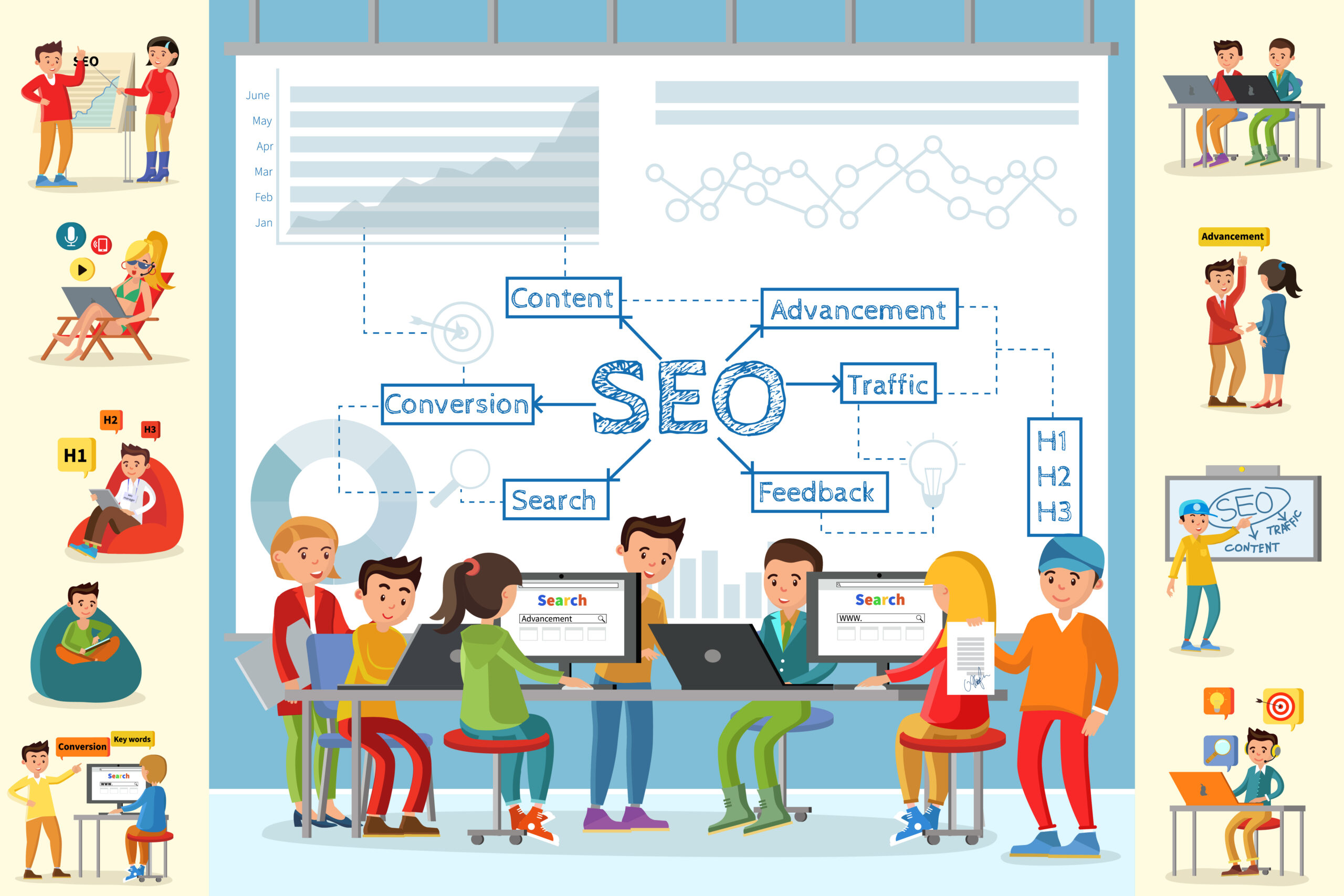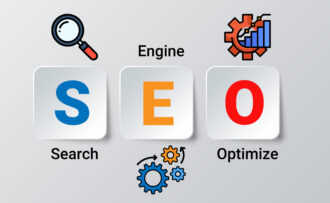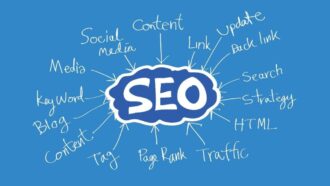The Significance of SEO in Website Development
- 1 What is Web Design with SEO?
- 2 4 Reasons SEO Matters for Web Design:
- 2.1 1. SEO-friendly websites draw more inbound links from organic search traffic.
- 2.2 2. More conversions come from SEO web design
- 2.3 3. User experience is enhanced by SEO web design
- 2.4 4. Your website becomes search engine friendly with SEO web design.
- 3 About Technical SEO in Website Design
- 3.1 Website Speed and Performance Optimization:
- 3.2 Mobile-Friendliness:
- 3.3 Crawlability and Indexability:
- 3.4 Website Structure and URL Optimization:
- 3.5 Schema Markup:
- 3.6 SSL Certificate and HTTPS:
- 3.7 Canonicalization and Duplicate Content:
- 3.8 Structured Data and Semantic HTML:
- 3.9 Optimized Images and Multimedia:
- 3.10 Robust and Efficient Code:
Most consumers do extensive research before making an internet purchase. Reviews and all other pertinent information important to a buyer’s decision-making are available on Google and other search engines.
To draw in, engage, and turn potential customers into devoted ones, you must invest in enhancing your brand’s online visibility as a business or seller.
You need a solid SEO strategy if you want your company to show up in the top few pages of the search results. SEO agencies work with web developers, designers, and others to guarantee that your website appears at the top of search results.
This post will discuss the value of SEO in site design and how it may improve your company’s online presence, lead generation, and revenue.
What is Web Design with SEO?
The process of creating a website that is optimized for both search engines and users is known as SEO web design. A responsive website with an excellent site structure, original content, and ease of navigation is what makes a website SEO-friendly.
We all know that having an online presence is crucial today, but for your company to prosper, people searching for keywords associated with your industry must find your website. Websites that do not appear at the top of search engine results pages are considered non-existent by users when they conduct online searches. It would help if you thus concentrated on making sure that your website appears at the top of the list for the relevant keywords. For a website to perform well in search engines, it must be SEO-friendly.
SEO is essential to web design and covers a broad variety of factors.
4 Reasons SEO Matters for Web Design:
1. SEO-friendly websites draw more inbound links from organic search traffic.
Your website will see an increase in organic traffic with the aid of SEO website design. Having a well-designed website that is simple to use and search can improve your chances of coming up top for the keywords you want to use.
With an optimized website, you can attract more search engine visitors who will likely become clients.
Obtaining traffic with a high purpose is perhaps more crucial than obtaining other kinds of traffic because it is more likely to convert. For this reason, you should make search engine optimization a top priority to raise your website’s rankings and boost organic traffic.
2. More conversions come from SEO web design
Attracting potential clients is the primary objective of your website. But you also have to be prepared for the following phase: turn them into sales.
The website is guaranteed to be optimized for conversion with an SEO-optimized web design.
When your website eventually receives high-quality traffic, SEO web design guarantees that users can easily and problem-freely complete the necessary activity, such as registering or purchasing.
Micro-conversions are also a part of SEO web design. Micro-conversions can include clicking a link to watch a video, subscribing to newsletters, or even completing a quiz. These can be found in every action, no matter how minor.
Users can learn more about your brand and business with each activity. This makes your brand more relatable to them and makes it impossible for them to avoid.
Users may bookmark content and return at a later time.
Hence, every action notifies you of a micro-conversion, indicating that every visit accomplished a goal. It is your responsibility as an SEO specialist to monitor these micro-conversions. In the long run, the statistics will assist you in further optimizing the user experience.
3. User experience is enhanced by SEO web design
The user’s experience is the primary consideration in web design. Unhappy website visitors and lost sales might result from poor user experience (UX).
You must make sure your website is both user-friendly and SEO-optimized if you want it to rank highly and turn visitors into leads.
You may provide visitors with a flawless experience by creating a website with search engine optimization in mind. This entails employing clear and concise text, ensuring your site loads quickly, and ensuring it is responsive and easy to use and navigate.
4. Your website becomes search engine friendly with SEO web design.
SEO and web design go hand in hand. These days, web designers incorporate SEO on purpose while designing a website. In what way, then, do these two entities collaborate?
Your website may prevent search engines from accessing your material even if it is elegant and visually appealing but not search engine optimized.
Search engine results will no longer display content from a website not optimized for search engines. The design of your website should consider several factors, such as technology, navigation, content, and links, to make it SEO-friendly.
Thanks to technological improvements, web designers and SEO specialists have more alternatives than ever to ensure the site’s design is optimized for search engines. Create your website with the user in mind, and you’ll rank higher and draw in more traffic.
About Technical SEO in Website Design
Technical SEO (Search Engine Optimization) in web design refers to the process of optimizing a website’s structure, code, and server configuration to improve its visibility and ranking in search engine results. While content and backlinks are important factors in SEO, technical SEO focuses on the backend elements of a website that affect its crawlability, indexability, and overall performance in search engines. Here’s a detailed overview of key technical SEO considerations in web design:
Website Speed and Performance Optimization:
Page loading speed is a crucial factor in both user experience and SEO. Search engines like Google consider page speed when ranking websites.
Techniques for improving speed include optimizing image sizes, minifying CSS and JavaScript files, leveraging browser caching, using Content Delivery Networks (CDNs), and reducing server response times.
Mobile-Friendliness:
With the increasing use of mobile devices, Google gives preference to mobile-friendly websites in its search results.
Responsive web design ensures that a website adapts to different screen sizes and devices, providing a seamless user experience across desktops, tablets, and smartphones.
Crawlability and Indexability:
Search engines use bots (crawlers) to navigate and index web pages. Ensuring that these bots can access and understand your website’s content is crucial for SEO.
Techniques to improve crawlability include creating an XML sitemap, using a robots.txt file to control bot access, and avoiding crawl errors like broken links and redirects.
Website Structure and URL Optimization:
A well-organized website structure helps search engines understand the hierarchy and relationship between different pages.
URLs should be descriptive, concise, and contain relevant keywords. Avoid using dynamic parameters and unnecessary characters in URLs.
Schema Markup:
Schema markup is a structured data vocabulary that helps search engines understand the content on a webpage more accurately.
Implementing schema markup can enhance search engine results with rich snippets, such as star ratings, reviews, and product information, leading to higher click-through rates.
SSL Certificate and HTTPS:
Google considers website security as a ranking factor. Implementing an SSL certificate to enable HTTPS encryption ensures secure data transmission between the user’s browser and the web server.
Websites with HTTPS protocol receive a slight ranking boost in search results compared to non-secure sites.
Canonicalization and Duplicate Content:
Canonical tags specify the preferred version of a webpage when multiple URLs have similar or duplicate content. This helps prevent issues related to duplicate content, which can negatively impact SEO.
Implementing canonical tags correctly can consolidate link equity and prevent search engines from indexing duplicate pages.
Structured Data and Semantic HTML:
Using semantic HTML markup helps search engines better understand the context and relevance of content on a webpage.
Properly structuring headings, paragraphs, lists, and other HTML elements according to their semantic meaning can improve SEO and accessibility.
Optimized Images and Multimedia:
Optimizing images for the web by compressing file sizes, using descriptive filenames, and adding alt text helps improve page load speed and accessibility.
Multimedia content like videos should be properly optimized with relevant metadata and schema markup for enhanced visibility in search results.
Robust and Efficient Code:
Clean, well-structured code improves website performance and makes it easier for search engine bots to crawl and index content.
Avoiding excessive use of JavaScript frameworks and minimizing render-blocking resources can improve page load speed and overall SEO performance.
Incorporating these technical SEO considerations into web design practices can help improve a website’s visibility, accessibility, and performance in search engine rankings, ultimately driving more organic traffic and better user engagement. Regular monitoring and maintenance are essential to ensure ongoing optimization and compliance with evolving SEO best practices.




















